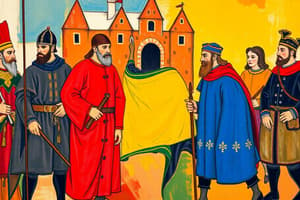Podcast
Questions and Answers
What was the central system that governed life during medieval times?
What was the central system that governed life during medieval times?
- Capitalism
- Communism
- Socialism
- Feudalism (correct)
Who were granted land by lords in exchange for military service during medieval times?
Who were granted land by lords in exchange for military service during medieval times?
- Serfs
- Knights
- Peasants
- Vassals (correct)
Where did the nobles typically reside during medieval times?
Where did the nobles typically reside during medieval times?
- Castles
- Grand manor houses (correct)
- Modest cottages
- Artisanal guilds
What was one purpose of the wars fought by powerful monarchies in the Middle Ages?
What was one purpose of the wars fought by powerful monarchies in the Middle Ages?
Which group was primarily responsible for securing a stable source of labor through the bondage of serfs in medieval society?
Which group was primarily responsible for securing a stable source of labor through the bondage of serfs in medieval society?
What type of opportunities did artisanal guilds provide during medieval times?
What type of opportunities did artisanal guilds provide during medieval times?
What was a key aspect of medieval culture according to the text?
What was a key aspect of medieval culture according to the text?
Which literary work is NOT mentioned in the text as a masterpiece from the Middle Ages?
Which literary work is NOT mentioned in the text as a masterpiece from the Middle Ages?
What was the primary purpose of scholasticism during the Middle Ages?
What was the primary purpose of scholasticism during the Middle Ages?
Which event temporarily resolved hostilities between England and France during the Middle Ages?
Which event temporarily resolved hostilities between England and France during the Middle Ages?
What contributed to the rise in literacy rates during the Middle Ages?
What contributed to the rise in literacy rates during the Middle Ages?
Which aspect of medieval times is associated with fostering international relations?
Which aspect of medieval times is associated with fostering international relations?
Flashcards are hidden until you start studying
Study Notes
A Glimpse into Medieval History
The period known as the Middle Ages, often simply referred to as the Medieval Times, spans from around 500 CE to approximately 1500 CE. This era saw immense changes shaping Europe's social, economic, political, and cultural landscapes. It's a complex tapestry filled with powerful kings and queens, valiant knights, courageous peasants, and innovative thinkers who left their indelible marks during this formative chapter of human history.
Feudalism and Society
At the heart of life during medieval times was feudalism—an intricate system based upon land ownership and loyalty between lords, vassals, and serfs. Lords granted land (fiefs) to vassals in exchange for military service and loyalty while securing a stable source of labor through the bondage of serfs.
Living conditions varied significantly across society. Nobles resided within grand manor houses, enjoying sophisticated lifestyles, fine cuisine, and elaborate clothing. Meanwhile, the majority lived in modest cottages or worked inside castles serving these nobility. While harsh working conditions were commonplace among the lower classes, artisanal guilds also flourished, providing opportunities for skill acquisition, social mobility, and trade across regions.
Kings and Wars
In the Middle Ages, powerful monarchies emerged, prompting ambitious rulers to embark on countless wars to expand their territorial holdings, consolidate power, or defend their lands against invaders. Crusades, conflicts over religious differences, and battles fueled by personal ambition all contributed to engulf large swathes of Europe in violence. However, even amidst tumultuous periods such as the Hundred Years War, there continued to exist instances of peace such as the Treaty of Troyes (1420), which temporarily resolved hostilities between England and France.
Religion and Philosophy
Central to medieval culture was religion, particularly Christianity, becoming deeply intertwined with every aspect of daily life. Monasteries acted as centers of learning, generating important texts and manuscripts paving the path for future advancements in philosophy, literature, and science. In contrast, religious institutions like the Inquisitions exemplified the darker side of the Church's influence.
Philosophically, the era witnessed the birth of scholasticism — an approach aimed at reconciling ancient Greek thought, Christian teachings, and Roman law. Notable figures such as Thomas Aquinas pioneered groundbreaking discussions regarding metaphysics, ethics, and the nature of God.
Trade, Technology, and Literature
Although typically associated with stagnancy, the Middle Ages witnessed several technological breakthroughs, including improved agriculture methods, better construction techniques, and advances in warfare technology. Additionally, maritime expansion connected distant peoples, fostering international relations and nurturing novelties such as paper money.
Concurrently, literacy rates rose due to increased accessibility of books produced using mechanized scribal practices. As a result, literary works flourished, giving rise to masterpieces like Dante Alighieri's Divine Comedy, Geoffrey Chaucer's Canterbury Tales, William Shakespeare's plays, and numerous others.
This brief overview merely scrapes the surface of an expansive epoch. Understanding the Middle Ages requires delving deeper into a panoply of subjects, each capable of captivating diverse interests and inspiring fresh perspectives.
Studying That Suits You
Use AI to generate personalized quizzes and flashcards to suit your learning preferences.




